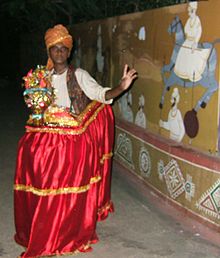Kachchhi Ghodi dance
 A Kachhi Ghodi dancer in a hobby horse costume | |
| Genre | Folk dance |
|---|---|
| Origin | Shekhawati, Rajasthan, India |
| Part of a series on the |
| Culture of India |
|---|
 |
Kachchhi Ghodi dance also spelled Kachhi Ghodi and Kachhi Gori, is an Indian folk dance that originated in the Shekhawati region of Rajasthan. It has since been adopted and performed throughout the rest of the country. Dancers wear novelty horse costumes, and participate in mock fights, while a singer narrates folk tales about local bandits. It is commonly performed during wedding ceremonies to welcome and entertain the bridegroom's party, and during other social settings. Performing the dance is also a profession for some individuals.
Etymology
[edit]In Hindi, Kachchhi has many possible meanings, two of which are "diaper" and "of or belonging to the Kutch region",[1] while Ghodi means mare.[2] Together, Kachchhi Ghodi refers to the imitation horse costume worn around the waist of the dancer.
Description
[edit]Kachchhi Ghodi includes a combined performance by dancers, singers and musicians. In Rajasthan, the dance is performed by men dressed in a kurta and a turban, along with an imitation horse costume.[3] The shell of the costume is constructed out of papier-mâché molded to resemble a horse supported by a bamboo frame.[4] It is then covered with bright colored fabric elaborately designed with mirror-work embroidery known as Shisha. The dummy horse does not have legs. Instead, fabric is draped around the dancer's waist covering the entire length of his legs. Around the ankles, the dancers wear musical bells known as ghungroo, similar to those worn by Indian classical dancers.[citation needed]
When performed as a group dance, people stand on opposite sides with swords in their hands and run back and forth quickly which, when viewed from above, resembles the opening and closing of flowers. The dancers move to the rhythm of flute music and the beats of dhol drums. Singers narrate the mock fights with stories of the exploits of Bhanwariya bandits, the Rajasthani equivalent of Robin Hood.[5]
Geography
[edit]
The dance originated in the Shekhawati region of Rajasthan.[6] It is prevalent in the Kamdholi, Sarghara, Bhambi and Bhavi communities.[citation needed] It is also performed with the same name in other parts of India, including Maharashtra[7] and Gujarat.[8]
In the state of Tamil Nadu, Poikkal kuthirai aattam (Tamil: பொய்க்கால் குதிரை ஆட்டம், which stands for false-leg horse dance) is a folk dance similar to Kachchhi Ghodi. The differences lie in the props used. It is performed with wooden legs meant to resemble the sounds made by the hooves of a horse during the annual festivals of the Amman Temple in Thanjavur.[9]
See also
[edit]References
[edit]- ^ "Kachchhi meaning in English". HinKhoj InfoLabs LLP. Retrieved 24 April 2015.
- ^ "Ghodi - Meaning in English". Shabdkosh.com. Retrieved 24 April 2015.
- ^ "Kachhi Ghodi Dance". Ananta Group Pvt Ltd. 15 March 2012. Retrieved 9 April 2015.
- ^ Gupta, Dr. Mohan Lal (11 April 2015). राजस्थान की पर्यावरणीय संस्कृति: Eco-Culture of Rajasthan. Shubhda Prakashan. p. 274.
- ^ "Kacchi Ghodi Dance (performed by men on dummy horses)". Padharo Rajasthan. Archived from the original on 10 April 2015. Retrieved 9 April 2015.
- ^ "Kachhi Ghodi Dance". Rajasthan Tourism Guide. Retrieved 9 April 2015.
- ^ Behrawala, Krutika (6 September 2014). "A royal visarjan for Siddhivinayak Ganpati in Mumbai". Times of India. Times News Network (TNN). Retrieved 9 April 2015.
- ^ Ramakrishnan, Swetha; Pundir, Pallavi (17 May 2014). "Delhi's Gujaratis rejoice: Modi makes dreams happen". The Indian Express. Retrieved 9 April 2015.
- ^ Mills, Margaret H.; Claus, Peter J.; Diamond, Sarah (2003). South Asian folklore: an encyclopedia: Afghanistan, Bangladesh, India, Nepal, Pakistan, Sri Lanka. New York: Routledge. p. 592. ISBN 0-415-93919-4.
External links
[edit]- "Kachhi Gori Folk Dances of Rajasthan". Dances of India. Pushpanjali. Retrieved 9 April 2015.
- https://wn.com/kachi_ghodi_dance/news – A video of the dance performance.
- https://web.archive.org/web/20150409190818/http://www.discoveredindia.com/rajasthan/culture-in-rajasthan/dance-in-rajasthan/
- https://www.youtube.com/watch?v=x-bEZlX7u8A - A Dance Video from Chokhi Dhani Pune.
